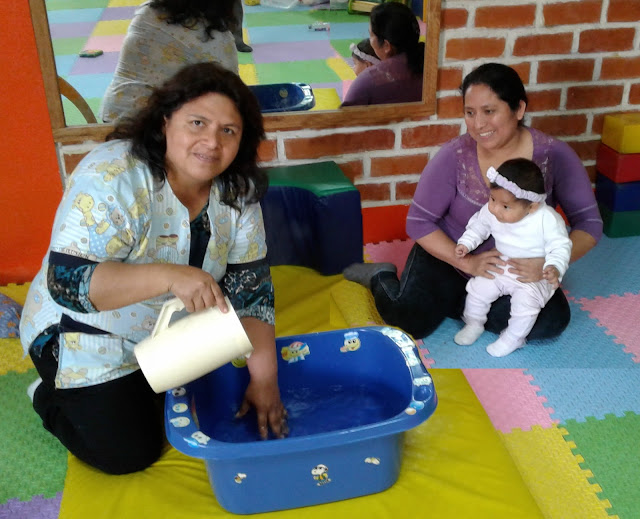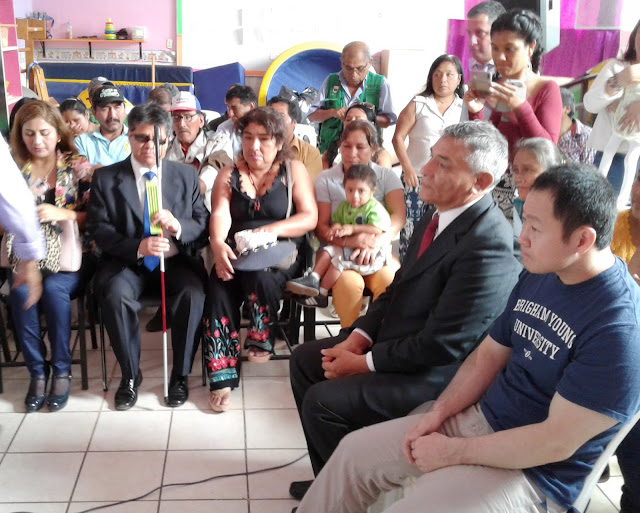Since arriving, we have worked on various clean water projects for poor communities that used to get their water out of polluted streams and rivers. However, we have recently come across a new challenge that goes beyond simply providing water - how to make it safe.
Clean Water vs. Safe Water
The wells, pumps, and tanks we have supplied have made life easier for many poor communities where previously they got their water from dirty streams. In other places, people use to get their water by buckets out of holes in the ground they had dug themselves. It is hard to believe how many people around the world still live in conditions where getting water is a daily chore.
Our donated wells have made life much better for those people that have received them. However, residents are told they should still boil their water before drinking. Most communities where we install wells are in remote agricultural areas with lots of animals. Besides, these communities only have outhouses which further contaminate the ground water. Thus, there is lots of coliform and E. coli bacteria in the ground water. Boiling is required to make the water safe.
 |
| This illustration from the Center for Affordable Water shows the problem that many of these communities face when fecal bacteria from humans and animals reaches a community's drinking-water source. |
Recently, a few of these communities have asked for the ability to chlorinate their water to make it safe to drink without boiling. That sounds like an easy solution that is not too expensive. However, the problem of making the water safe is very complicated.
 |
| Typical small chlorination pumps we have looked at that are suitable for the wells we install. Cost is around $500 to $700. |
With a chlorination pump, you just mix household bleach with water in a mixing tank, put a hose into the mixing tank with the bleach mixture, run the hose to the chlorination pump, and then put the output into the holding tank on the tower along with the water coming from the well. So simple! Not really when you consider the following:
- Who will mix the bleach with the water so the mixture is correct, all the time, for years to come? (Only poor farmers live in these communities).
- What happens if the mixture is too strong (too much chlorine can kill) or too weak (the bacteria remains alive)?
- How will they monitor the system to make sure the right levels of chlorine are maintained?
- How often will the system be monitored? Hourly, daily, weekly, or monthly?
- How long will it take to notice and react if the chlorination pump fails or if it runs out of chlorine?
On our Monsefu project this week, we hesitantly agreed to supply the chlorination pumps for 18 wells. However, we put the responsibility for training, maintaining, and monitoring the system into the hands of the Monsefu district government.
Residents are ecstatic about the possibility of not having to boil their water, but we remain cautious about the many risks involved. We even signed a contract addenda with the government in order to shift this risk and responsibility to them for ensuring the safe operation of the chlorination pumps. The government told us they have everything under control, but we remain a little worried.
This whole issue of clean vs. safe water is a major concern for us. Just giving a community a chlorine pump may not solve the problem if the other questions above are not answered.
Fortress Real Felipe in Callao
On Saturday, our day off, we journeyed across Lima to the district of Callao to visit a fortress built by the Spaniards in the 1700s. Fortaleza Real Felipe is a star-shaped fortress, the largest of its kind built by the Spanish outside of Spain.
 |
| The fortress, Fortaleza Real Felipe, built by the Spaniard to defend their colony of Peru. |
Star forts, found throughout Europe, were very difficult to attack because of their shape. This fortress was attacked several times by foreign navies who wanted the riches found in Peru, but the fortress never fell.
 |
| Aerial view of the star-shaped fortress. Cannons placed on the top walls could defend the entire port and repel any land assault. |
Peru was a treasure for the Spaniards. After conquering the Incas (and stealing their riches), they put the natives to work as slaves in the gold and silver mines. All the riches that were sent back to Spain during this period came through this fortress.
Real Felipe was like the Fort Knox of Peru, guarding the gold and silver until it could be loaded onto ships bound for Spain.
 |
| Real Felipe is an impressive fortress with its walls, towers, and cannons carefully preserved. |
 |
| With its cannons still positioned to defend, Real Felipe looks like it is ready to be called back into action at any time. In fact, the Peruvian Army still has troops stationed at the fortress. |
 |
| The district of Callao built right up to the fortress on all sides - an ancient fortress surround by a cosmopolitan city. |
The most prominent part of the fortress is a 3-story circular tower called the King's Tower. This solid tower, built from rock brought in from a nearby island, is filled with maze-like passages. It has no windows and only one entrance with a draw bridge. It was the safest place in the entire fortress, good for securing treasures. It was later used as a prison where many perished from neglect.
 |
| King's Tower, the most fortified spot in the fortress. |
 |
| The draw bridge is the only way into the King's Tower |
 |
| If you were an enemy of the Spanish crown and got sentenced to time in the King's Tower, you went in this door, but you never came back out alive. |
Interestingly, prior to the Peruvian War of independence, the local Peruvians gained control of the fortress. They fought off the Spanish forces from the fortress and eventually won their independence.
The fortress was an interesting look at more of the architectural treasures from the colonial Spanish period. This was a fun little adventure.
Port of Callao
After the seeing the fortress, we walked across the street to the harbor. The Port of Calloa is a nice retreat from the rest of Lima - beaches and fancy boats - what a great escape!
 |
| What a beautiful day at the port. |
We hopped on a tour boat to look at the million-dollar yachts moored in the harbor and see all the sun worshipers on the beaches.
 |
| Our tour boat looked like something between a shark and a whale. |
 |
| Fleets of fishing boats in the harbor bring tons of fish into Lima each day. |
 |
| A dream yacht - it only costs $14 million. Ah, having that much money would canker my soul! Maybe we'll leave that temptation for someone else! |
 |
| We floated by all the revelers and families on the dock and the beach at Callao. What a nice warm day for some fun in the sun. |
Callao has a reputation as being a dangerous place to visit (drugs, gangs, thieves). But our Saturday turned out to be a nice day at the fortress and port. Too bad it takes two hours to get to Callao from where we live or we would come back again.
What to do with your Llama in Lima
We occasionally see people in Lima with llamas showing them to the tourists. The question one asks is "What do you do with a llama in this big city at the end of the day?"
Some people end up hauling their animals in unusual ways back home after a day in the tourist sights. I found some shots of people transporting their animals in taxis, buses, and on top of cars.
 |
| With a little coaxing, these folks got their llama into the baggage compartment of a bus. |
But, if you can tie their legs and then strap them together, it seems like llamas actually enjoy the fresh air and scenery while riding 'up on top'.
 |
| What a fun way to travel! Lots of fresh air, sunshine, and fun with your fellow llamas on top of the car. Count carefully and you will note five on top and at least one inside. |
And, again, anything is possible in Peru!



































